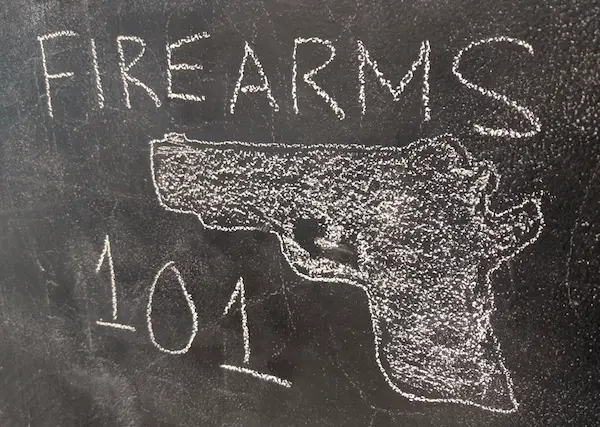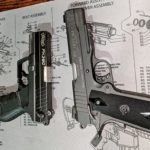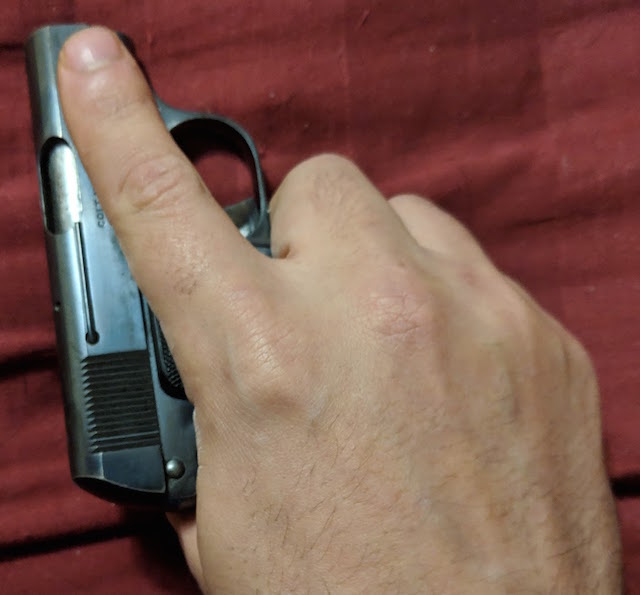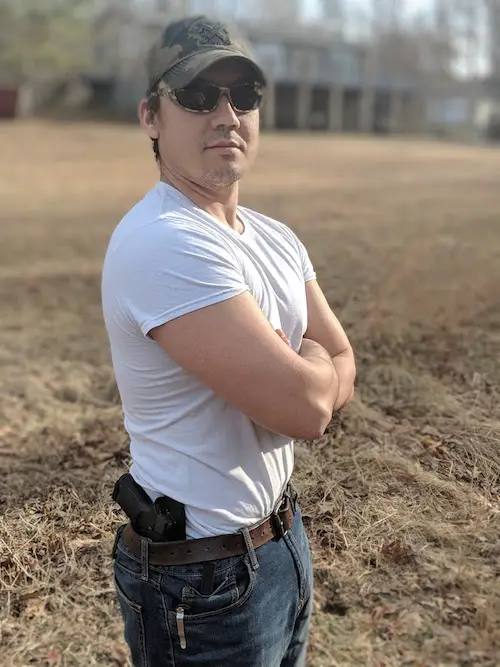If you’re looking to get your concealed carry training, you may have some questions. However, I’m here to provide some clarity about what you can expect to encounter during a concealed carry course. Maybe you need to satisfy a state requirement to obtain your CCW license. Or perhaps you’re considering concealed carry and want to beef up your knowledge. Whatever the reason, I’ll be going over some common questions and their answers.
Table of Contents
What Is Concealed Carry Training?
In order to obtain a concealed carry permit, many states require proof of competency in the safe handling of firearms and the laws governing concealed carry in your state. Additionally, many concealed carry training courses provide best practices for general firearm handling, maintenance, marksmanship, and state reciprocity.
Because state requirements and laws vary, the curriculum will be different from state to state. Some states require live fire exercises as part of your training and therefore must be conducted in-person by the instructor. Before enrolling in an online concealed carry training course, I highly recommend checking your states’ competency requirements by checking the concealed carry map on the homepage.
What To Expect In A Concealed Handgun Class
The primary function of concealed handgun class is to ensure you have a thorough understanding of basic firearm safety, firearm storage, use of deadly force, and your states’ firearm laws. You can expect to cover the following material in a good concealed handgun class:
- How to safely load, unload, and maintain a handgun
- Transporting and storing handguns
- Avoiding the use of deadly force and when it is warranted
- Where you can and cannot carry a concealed handgun in your state
- States with reciprocity (other states where you can carry with a permit from your state)
- General marksmanship (aiming and shooting)
- Other laws governing concealed carry in your state
How Long Is Concealed Handgun Class?
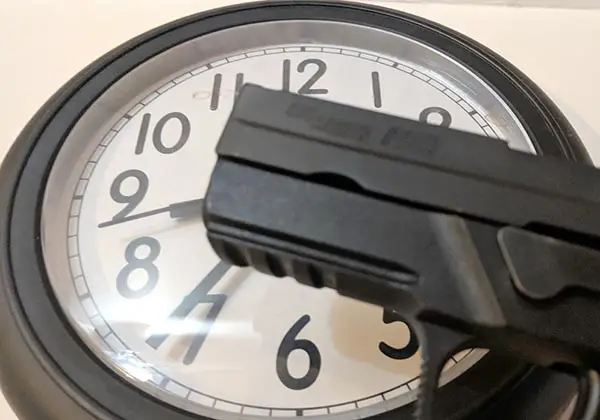
The duration of your concealed handgun class will depend entirely on the instructor, method of instruction, and what constitutes the testing portion. If you are taking an online course, you can expect the concealed handgun class to last between 1 and 4 hours to cover the course materials.
Additionally, some states require handgun classes to be a certain duration to meet standards. Click on your state in the map on the homepage to see more detailed information about your states competency requirements. Those pages also provide details about what constitutes acceptable education.
Do You Need A Gun To Take A Concealed Carry Class?

Unless your state requires a live fire exercise as part of the curriculum or testing to obtain a concealed carry permit, you will not need a gun to take a concealed carry class. Many states accept concealed carry courses conducted exclusively online and handgun ownership is not a prerequisite for course registration.
There are two ways to satisfy the education component for a concealed carry permit. First, you can take an in-person concealed handgun course. If your state accepts it, you can instead take an online concealed handgun class.
Because the state decides what is an acceptable form of education, it is recommended that you reference the training requirements for your state before class registration. Although,If your state requires a live fire exercise as part of certification it would be prudent to bring your own firearm. Additionally, some states restrict concealed permit issuance based upon shooting performance of a specific caliber of weapon.
How Much Does A Concealed Carry Class Cost?
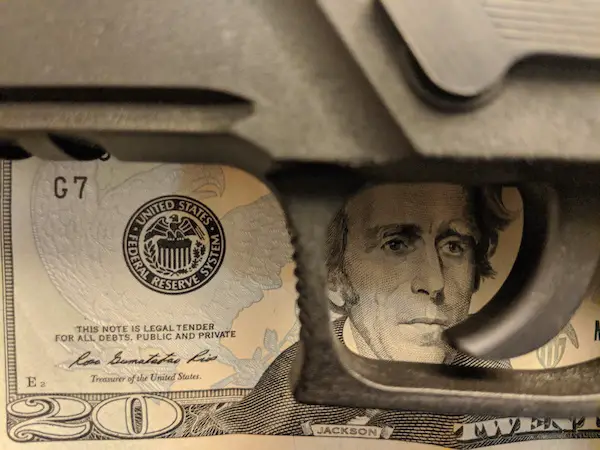
When registering for an online concealed carry class, you can expect to pay between $20 – $60. Although some courses advertise “free” concealed carry instruction, they are seldom (if ever) truly free. Usually, these sites will require you to pay a fee to acquire the certificate you’ll need to submit to your municipality.
If an online concealed carry course is accepted by your state, I highly recommend one that is forthcoming about the cost. Generally, these sites provide sufficient instruction and course materials to make it worth your while. Personally, I recommend concealedcarry-ed.com, as I have reviewed their course materials and found them both accurate and informative.
How Long Does A Concealed Carry Training Certificate Last?
The validity of a concealed carry permit will vary from state to state. However, concealed carry permits are usually valid for between 2-5 years from the date of issuance depending on the state. However, concealed carry training certificates are usually valid for up to 1 year from date of completion. During this period you will need to complete your application for a concealed carry permit for the course to be sufficient for your education requirement.
In addition to completing classroom instruction, some states require in person instruction on the safe handling of firearms. Furthermore, these states may require proof of competency with marksmanship as part of the concealed permit application process. I recommend you review the education requirements for your state.
How Old Do You Have To Be For A Concealed Handgun Class?
I have not seen an age requirement for taking a concealed handgun course to date. However, you should verify the age requirements for getting a concealed handgun permit in your state prior to course registration. Additionally, you’ll need to ensure what types of courses meet the states concealed carry education requirement. Finally, check state requirements for the valid time frame for concealed handgun course completion.
For example, some states allow a hunter safety course to suffice for the education requirement to obtain a CCW. I have seen children participating in these hunter safety courses. However, those students were ineligible for a concealed permit at the time of instruction. Even when they come of age, they may need to retake the hunter safety or concealed handgun class to meet the state requirements because the original certificate is no longer valid.
Concealed Carry Training Requirements
Concealed carry curriculum depends upon the state where you are trying to become licensed. However, there are at most 3 components to concealed carry training. First, is classroom education. Oftentimes this can be completed online, or from a certified instructor.
Second, some states require in-person live fire instruction on the range. Finally, there is an exam at the culmination of training. Generally, there is at least a written exam. Written exams vary, but you can expect them to be at least 20 questions long. Furthermore, if your state requires live fire instruction, it may also require a live fire proficiency exam.
Is Online Concealed Carry Training Accepted?
I highly recommend you check with both the institution offering instruction, as well as local laws, to ensure the course meets concealed carry training requirements. While many states accept online concealed carry training courses, the issuing authority (or state) will set the guidelines for acceptable instruction. This can include specific courses, instructors, course duration, and course material. Should you be in a state that requires live-fire exercises as a component of instruction then courses taught exclusively online will not be accepted.
Below is a list of several states that do not consider training conducted exclusively online as acceptable for a concealed weapons permit:
- Tennessee
- South Dakota – Enhanced
- South Carolina
- Rhode Island
- Ohio
- North Dakota
- North Carolina
- New Mexico
- Missouri
- Minnesota
- Michigan
- Louisiana
- Kentucky
- Kansas – Online courses expressly forbidden
- Illinois – Online courses expressly forbidden
- Delaware – Online courses expressly forbidden
Many of the above listed states require live-fire exercises or the presence on an in-person instructor as a condition of training. However, if there is a classroom component, these states may still consider online training acceptable for that portion. Consult the expanded concealed carry laws and reciprocity pages for further detail. Regardless of what the law dictates, a concealed handgun class is still a valuable investment.
Live Fire Exercises
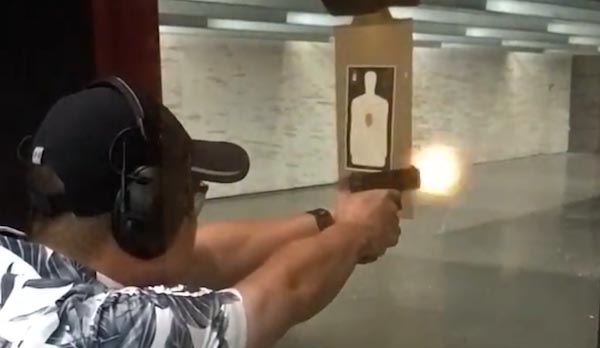
Live fire exercises required by the state make online concealed carry instruction unacceptable. Oftentimes, course participants are required to prove proficiency with a handgun at set distance intervals. Additionally, some states require that you “qualify” with the caliber of handgun you intend to conceal carry. Sometimes, live fire instruction must be for a set duration to qualify a concealed carry training course as acceptable.
Classroom Time
How long you spend in the “classroom” depends upon the depth of the course materials. However, it is to your benefit to get a comprehensive course. Some online courses on concealed carry will only provide a single free video and model their exam questions off of the material they cover. Unfortunately, these short videos provide very little education on the depth of knowledge for concealed carry. You are likely to cover as much, if not more, pertinent information during your local shooting range safety video.
Remember to pay attention, there will be an exam!
A quality course will provide plenty of written documentation on the course materials in addition to multimedia instruction on concealed carry. If you want to get a foundation for the basics of safe firearm handling, I suggest you check out this article. Additionally, I recommend you check out concealedcarry-ed.com for your concealed handgun training, which has plenty of supporting documentation for students.
Concealed Carry Test
Generally, any form of training culminates in a final exam. Whether it involves actual lane time at a gun range will depend on your instructor and state requirements. Below are some things you may want to try once you’ve completed a concealed handgun course.
Concealed Handgun Class Practice & Drills
If you’re going to get comfortable with concealed carry, then you must put into practice all of the material covered in a quality training course. While not required for a concealed handgun class, you’ll need to have the handgun you plan to carry and a holster, at a bare minimum.
However, it would also be prudent to pick up a basic cleaning kit so that you can maintain your handgun after a practice session at the range. Additionally, you’ll need some kind of home firearm storage for when you aren’t shooting.
Practice Clearing Your Handgun
I’ve found the best way to familiarize yourself with the curriculum of a concealed handgun class is with hands on experience. One basic exercise to help you become accustomed to handling a firearm is clearing the weapon. Clearing a handgun is a skill that anyone who safely handles a weapon is familiar with. Ideally, new students will work with someone more experienced when initially practicing.
Depending on the type of handgun (e.g. automatic, revolver, single-shot) the process will vary. A good concealed handgun class will provide instruction about these platforms and how to properly clear them. This exercise reinforces the basic safety rules, while also exposing you to loading and unloading your handgun.
Field Strip Your Handgun And Clean It
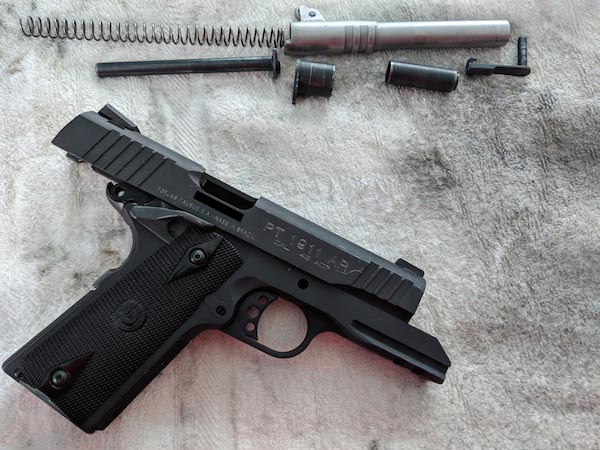
Once you are comfortable clearing your handgun, you should familiarize yourself with the process of field stripping your weapon. After you shoot, and at regular intervals, you need to thoroughly clean your weapon to ensure proper functionality. Additionally, field stripping a weapon can help you understand the inner workings of your firearm.
I’ve got a few tutorials on field stripping weapons here. It’s worth checking out these tutorials even if your model of handgun is not listed. Oftentimes, manufacturers use the same takedown features across multiple models of their handguns. I will be updating this section with additional tutorials as opportunities present themselves.
Dry Fire Exercise
If your state happens to require you to actually shoot your pistol as part of your concealed carry instruction, then dry fire exercises are a good place to start. To perform a dry-fire exercise, unload your weapon and make sure the chamber is clear. Next, you cock the hammer, if applicable to your model of firearm. Finally, point the empty weapon at a target — remember the 4 safety rules — and squeeze the trigger. That’s it!
First, this will get you accustomed to aiming your pistol. Second, this technique reinforces the 4 basic firearm safety rules. Finally, you can begin to determine (and break) bad trigger pull habits. Additionally, you’ll build strength and muscle memory for holding a handgun on target. For tips on improving your aiming ability, check out my article on using 3 dot sights.
Practice Exam Questions

All of the above exercises are fantastic for a hands on approach to learning about firearm safety. However, you will likely have to take a written exam before you receive a certificate of completion for your concealed carry course. But, not everyone is great at taking tests.
If you know that test-taking isn’t up your alley, you’ll need to find some practice exams. A good concealed carry class will have practice tests for you to take prior to your final exam. To help ensure student success, a good concealed handgun course will provide students with a study guide to help prepare for the testing portion.
In my experience, safety is of paramount importance during concealed handgun exams. Additionally, you’ll need to brush up on the laws for your state. However, you likely won’t find practice exams tailored to your state’s laws because of the diversity of regulations from one state to the next.
Parting Shots
Hopefully I’ve addressed many of your questions about concealed handgun courses. If you have additional questions that weren’t answered, please leave a comment below. Chances are the rest of the community is thinking something similar.
